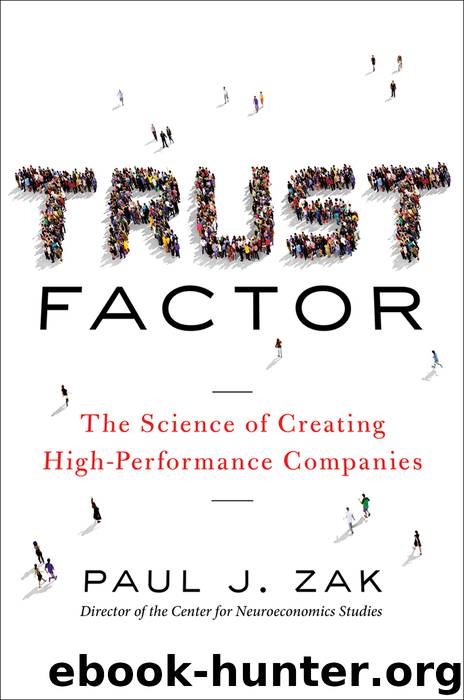Trust Factor by Paul J. Zak

Author:Paul J. Zak
Language: eng
Format: epub
Publisher: American Management Association, AMACOM Division
Published: 2016-03-18T04:00:00+00:00
Chapter 8
Invest
Organizations Invest in colleagues when they enable whole person growth. Invest explains 72 percent of organizational trust.
Fully one-third of human resources managers surveyed in 2015 said that retaining colleagues is their number one concern. Everyone knows that employees are mobile. About one-quarter of employees say they will look for a new job in the next year. Some are chasing a higher salary (23 percent), but nearly as important is the desire for a better opportunity (19 percent), a failure to be appreciated (16 percent), and unhappiness with growth opportunities at their present organization (13 percent). Employers underestimate the importance of personal and career development on employee retention, vastly overestimating the importance of salary and benefits.1 As Josh Bersin, founder and principal at Bersin by Deloitte, has said, “The war for talent is over, and the talent has won.”2
It is actually worse than that. A third of employees believe their current job skills inhibit their productivity and are holding them back from career growth. Who’s to blame? Three-fourths of employees say they do not have a clear professional development path, and 31 percent don’t feel their employer has trained them adequately.3 Accenture’s 2015 survey of college graduates finds that “employers’ lack of commitment and investment in entry-level jobs” is the number one reason that highly sought-after STEM (science, technology, engineering, and math) graduates eschew working for large companies.4 For those in their 20s, the most important factor in selecting a workplace is professional development.5
Even though companies worldwide report that retention and engagement is a “highly urgent” concern, the average company spends only 31 hours a year training colleagues.6 High-Invest organizations, as defined by the Association for Talent Development, do much better, averaging 49 hours of training annually.7
Across industries, Invest is nearly always the lowest of the OXYTOCIN factors. Many organizations Invest in colleagues only as an afterthought, signaling that they do not trust colleagues enough to provide them with new opportunities. Invest is not as simple as increasing training hours for employees or sending them to a conference. Invest recognizes that volunteer-employees have multiple goals at work and in life. By facilitating growth of colleagues as human beings, Invest provides the foundation for a long-term commitment to the organization.
This chapter introduces the Whole Person Review, which, in conjunction with the previous factors discussed in the book, radically changes the annual review process into a forward-looking guide to growth. We see how companies such as SAS Institute, Zappos.com, and theater operator Decurion Corp. Invest in colleagues in order to increase organizational performance.
Just as fully engaging in life requires a movement toward greater well-being, the evidence shows that fully engaging at work requires more than just job skills.8 If we want colleagues to bring their heads and hearts to the job, we need to also consider how their professional, personal, and spiritual development interact with each other—something I call whole person development.
Philosophers and psychologists agree. Aristotle thought that personal growth came from the acquisition of practical wisdom and believed this was the foundation for human flourishing.
Download
This site does not store any files on its server. We only index and link to content provided by other sites. Please contact the content providers to delete copyright contents if any and email us, we'll remove relevant links or contents immediately.
Bad Blood by John Carreyrou(6472)
Rich Dad Poor Dad by Robert T. Kiyosaki(6313)
Principles: Life and Work by Ray Dalio(6116)
Playing to Win_ How Strategy Really Works by A.G. Lafley & Roger L. Martin(5745)
Management Strategies for the Cloud Revolution: How Cloud Computing Is Transforming Business and Why You Can't Afford to Be Left Behind by Charles Babcock(4492)
The Confidence Code by Katty Kay(4154)
Thinking in Bets by Annie Duke(4117)
American Kingpin by Nick Bilton(3707)
Delivering Happiness by Tony Hsieh(3331)
Project Animal Farm: An Accidental Journey into the Secret World of Farming and the Truth About Our Food by Sonia Faruqi(3139)
The Power of Habit by Charles Duhigg(3016)
The Tyranny of Metrics by Jerry Z. Muller(2953)
Mastering Bitcoin: Programming the Open Blockchain by Andreas M. Antonopoulos(2948)
Brotopia by Emily Chang(2947)
The Marketing Plan Handbook: Develop Big-Picture Marketing Plans for Pennies on the Dollar by Robert W. Bly(2900)
I Live in the Future & Here's How It Works by Nick Bilton(2898)
The Content Trap by Bharat Anand(2835)
Applied Empathy by Michael Ventura(2808)
Building a StoryBrand by Donald Miller(2803)
